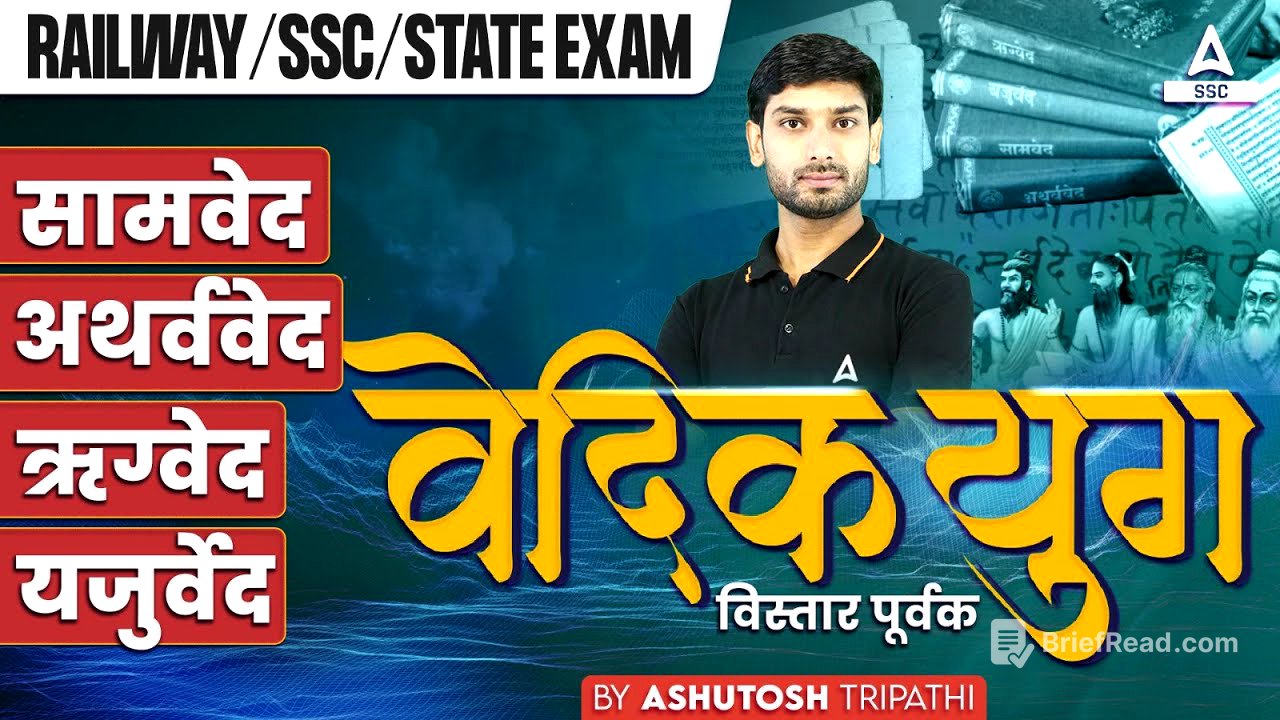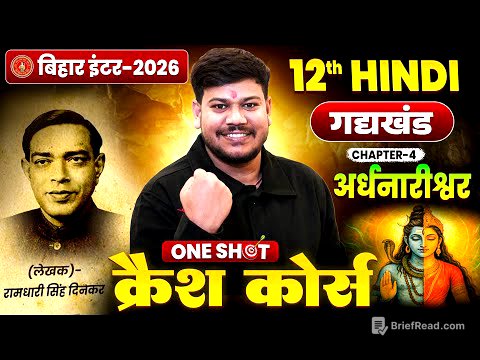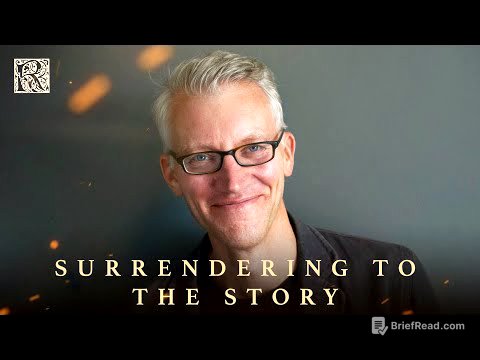TLDR;
This YouTube video by SSC Adda247 is an informative session on Vedic Age, focusing on the four Vedas: Rigveda, Yajurveda, Samaveda, and Atharvaveda. The instructor explains the key aspects of each Veda, including their structure, associated Brahmanas, and significance. The session also touches upon social aspects of the Vedic period like Varna system and Gotra system, clarifying common misconceptions.
- The Vedas are not written but compiled knowledge.
- Each Veda has associated Brahmanas that help in understanding the core text.
- Social structures like Varna and Gotra had logical reasons behind their formation.
रेलवे रफ्तार रीजनिंग [0:03]
Atul Awasti sir talks about Railway "Raftar" Reasoning, promising students will be able to confidently answer any reasoning question in railway exams. He assures full marks in reasoning for any railway exam. He invites students to join Railway Adda 247 and attend his class at 11 AM daily.
Introduction to Vedic Age [1:04]
The instructor welcomes the audience to SSC Adda 247. He mentions that he will be taking theory classes for a few days, covering topics from Vedic Age, Polity, and Geography. He requests viewers to provide feedback on the content and their understanding in the comment box. He assures that there is no difference between his teaching on YouTube and in paid classes.
Understanding the Vedas [2:59]
The session starts with a discussion on the four Vedas, specifically Rigveda, Yajurveda, Samaveda, and Atharvaveda, without initially focusing on the Aryans. The instructor highlights the importance of these Vedas and promises to dedicate time to each one. He mentions that Rigveda is particularly important due to the frequency of questions asked from it.
Rigveda: Structure and Significance [3:46]
The instructor starts explaining Rigveda, clarifying that Vedas are knowledge compiled by Ved Vyas, not written by any individual. Vedas are also known as Samhita and Shruti Samhita. Rigveda is divided into 10 Mandalas (chapters), 1028 Suktas (hymns), which includes 1017 hymns given by Gods and 11 hymns written by humans, also known as 'Bal Khil'. There are 10,580 Richas (verses) in Rigveda according to old NCERT books.
Key Aspects of Rigveda [9:46]
Veda Vyas compiled the Rigveda. The person who recited or explained Rigveda to the public was a Rishi named Hotra. To understand Rigveda better, Brahmanas were created as guides. Aitareya Brahmana and Kaushitaki Brahmana are two such texts. Aitareya Brahmana refers to daughters as 'Kripan' and considers them a source of sorrow, while sons are seen as protectors of the family.
Important Mandalas of Rigveda [12:38]
The instructor discusses important Mandalas (chapters) of Rigveda from which questions are frequently asked. The third Mandala contains the Gayatri Mantra, written by Vishwamitra and dedicated to the deity Savitr (Sun). The seventh Mandala describes the Dasarajna War (Battle of Ten Kings) fought between King Sudas of the Bharata dynasty and a coalition of ten tribes led by Vishwamitra on the banks of river Parushni, now known as Ravi. The ninth Mandala is dedicated to Soma, considered equivalent to Lord Shiva, and the intoxicating drink, Somras.
Tenth Mandala and Social Structure [18:19]
The tenth Mandala of Rigveda mentions the Varna system, which is also first mentioned in Jabala Upanishad. The Varna system divided society into Brahmins, Kshatriyas, Vaishyas, and Shudras based on occupation. The instructor clarifies that in Vedic times, this division was based on कर्म (karma) but later became hereditary. The tenth Mandala also mentions Gotra system, which was originally implemented to prevent attraction between opposite sexes within the same community serving at Rishi's Ashram.
Understanding Gotra System [25:16]
The instructor explains the concept of Gotra, linking it to the practice of people serving cows at the ashrams of different Rishis. People serving cows at one place were considered of the same Gotra, and marriage within the same Gotra was prohibited to promote a brother-sister relationship and prevent genetic defects. Also, marrying in different gotras would give the child knowledge from both parents.
Ashram System and Structure of Rigveda [31:00]
The instructor explains the Ashram system mentioned in Rigveda, dividing life into Brahmacharya (0-25 years), Grihastha (25-50 years), Vanaprastha (50-75 years), and Sanyasa (75-100 years). He also mentions that Ayurveda is the Upveda (subsidiary Veda) of Rigveda, written by Prajapati. The second to seventh Mandalas are the oldest, known as Vansh Mandalas, while the first and tenth are the newest. The eighth and ninth are mixed-age Mandalas.
Comparison and Key Takeaways from Rigveda [34:55]
The instructor summarizes key points about Rigveda, including the phrase "Asato Ma Sadgamaya." He notes similarities between Rigveda and the Iranian text Avesta. Samaveda is based on Rigveda, with its mantras set to music.
Yajurveda: Rituals and Sacrifices [36:01]
The instructor transitions to Yajurveda, describing it as a कर्म कांडीय (ritualistic) Veda with mantras related to sacrifices. It mentions the practice of raising elephants. Yajurveda is unique as it is written in both prose and poetry. The Rishi who recited Yajurveda was Adhvaryu.
Divisions and Brahmanas of Yajurveda [37:47]
Yajurveda is divided into Krishna Yajurveda and Shukla Yajurveda. Shukla Yajurveda is also known as Vajasaneyi Samhita. To understand these divisions, Brahmanas were created. Satapatha Brahmana explains Shukla Yajurveda, while Taittiriya Brahmana explains Krishna Yajurveda. Satapatha Brahmana is the most voluminous Brahmana. The oldest Brahmana is Tandya Brahmana.
Upveda and Last Chapter of Yajurveda [40:28]
The Upveda of Yajurveda is Dhanurveda, associated with Vishwamitra. The last chapter of Yajurveda is Isha Vasya Upanishad.
Samaveda: The Veda of Melodies [41:48]
The instructor moves on to Samaveda, which has 1875 verses and is based on Rigveda. It is considered the origin of Indian classical music. The person who sang or explained Samaveda was Udgatri. The Upveda of Samaveda is Gandharva Veda, associated with Narada.
Brahmanas and Divisions of Samaveda [43:50]
Several Brahmanas are associated with Samaveda, including Shad Vims, Panch Vims, Chhandogya, and Jaiminiya. Panch Vims is also known as Tandava Brahmana and is considered the most ancient. The instructor asks the audience to name the two parts of Samaveda in the comment box.
Atharvaveda: Spells and Knowledge [46:18]
The instructor discusses Atharvaveda, believed to be composed by Rishi Atharva or Angira. It is also known as Shrestha Veda, Brahma Veda, and Black Veda. It contains knowledge of Ayurveda. The text was sung by Gopath. It mentions that Sabha and Samiti are two daughters of Prajapati.
Upveda and Key Aspects of Atharvaveda [48:44]
The Upveda of Atharvaveda is Shilpa Veda, associated with Vishwamitra. Atharvaveda has 731 Suktas, 20 chapters, and about 6000 mantras. Mundaka Upanishad, which contains the phrase "Satyameva Jayate," is part of Atharvaveda. King Parikshit is referred to as the देवता (devata) of मृत्युलोक (Mrityuloka) in this Veda.
Course Promotion and Conclusion [50:24]
The instructor promotes his paid courses on Adda247, especially the महा पैक (Maha Pack) for SSC MTS and Railway exams. He encourages students to use the coupon code Y1A2 for a discount. He emphasizes the importance of GS and English for the MTS exam. He concludes by thanking the audience and asking for feedback in the comment box.









